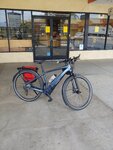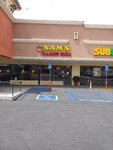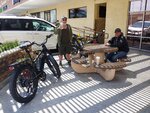Stefan Mikes
Gravel e-biker
- Region
- Europe
- City
- Mazovia, PL
Then we exclude the weight from the equation, NBS 







You're right -- I misunderstood your original statement. From another page on bicycle efficiency:Drag force increases in the square power, Roch, and the power demand in the third power. Trust me.
I forgot to say my average speed was 25.2 km/h (15.8 mph). Also, I think your own input Kam is far higher than mine!Average speed to and from. 13.9 mph. Let's round it off at 14 mph. Finished ride with 69% battery remaining.
I was always poor on the Mechanics, Roch. That was my Achilles heel during my University timesI'll have to admit, something doesn't seem quite right here, but it's been over a half century since my engineering degree and I've forgotten most everything else that happened that long ago...
I don't know. Maybe, maybe not. I'd have to see the stats. Can hardly wait for you to get the TCD-w upgrade. Yes. I do try to get a workout most of the time. I'm still tweaking the assist levels to compliment my own power. 14 mph average for a 30 mile ride at approximately 1 % per mile is decent. Especially with the wind, 25 pounds in my Ortlieb bag, my weight, 185 pounds and hills. I'd like to get an Average speed of 16 mph at the same distance/ route with the same 1% battery depletion per mile.I forgot to say my average speed was 25.2 km/h (15.8 mph). Also, I think your own input Kam is far higher than mine!
I was always poor on the Mechanics, Roch. That was my Achilles heel during my University times
Your riding parameters are a lot like mine -- similar power, etc. I'm not getting much chance to ride these days (like a second winter out there today!) and am still tweaking my settings. I'll have to especially try your Eco settings (which I saw in the other thread) with low assist and especially low peak power. I'd like to be able to ride in Eco in flatter terrain and get about the same physical benefit as on my standard bike of similar configuration (Specialized Crosstrail), just using higher boost for hills or when I can use the help getting back from a long ride.I don't know. Maybe, maybe not. I'd have to see the stats. Can hardly wait for you to get the TCD-w upgrade. Yes. I do try to get a workout most of the time. I'm still tweaking the assist levels to compliment my own power. 14 mph average for a 30 mile ride at approximately 1 % per mile is decent. Especially with the wind, 25 pounds in my Ortlieb bag, my weight, 185 pounds and hills. I'd like to get an Average speed of 16 mph at the same distance/ route with the same 1% battery depletion per mile.
I estimate my leg power to be 84 W (yours is 113), I'm heavier and riding probably more upright. So what. The batteries are there to be used
I think I'm learning how to shift down before I hit the hills. Going up the hill pedal as much as I can on my own power. Then switch on ECO to help me sustain it at faster rate of speed.. I noticed I can go faster spinning more as opposed to just leaving in same gear on the flats. I read here that it's easier on the drive train if you do this and easier on the chain.Your riding parameters are a lot like mine -- similar power, etc. I'm not getting much chance to ride these days (like a second winter out there today!) and am still tweaking my settings. I'll have to especially try your Eco settings (which I saw in the other thread) with low assist and especially low peak power. I'd like to be able to ride in Eco in flatter terrain and get about the same physical benefit as on my standard bike of similar configuration (Specialized Crosstrail), just using higher boost for hills or when I can use the help getting back from a long ride.
The motor torque curve published in another thread shows that peak motor power is attained at cadence levels above 70rpm. Another good reason to spin, esp up hill!I think I'm learning how to shift down before I hit the hills. Going up the hill pedal as much as I can on my own power. Then switch on ECO to help me sustain it at faster rate of speed.. I noticed I can go faster spinning more as opposed to just leaving in same gear on the flats. I read here that it's easier on the drive train if you do this and easier on the chain.
As Stefan says, it is important not to have the drivetrain "under load" when shifting if possible. This is true for any derailleur system, but especially on an e-bike where the added torque from the motor can really "jerk" the drivetrain, which is hard on the chain and on the gear teeth. Some e-bike systems -- Bosch for one I believe -- have a shift detection mechanism that effectively kills the motor for an instant when you move the shift lever, but the Brose system doesn't do this. When upshifting, I also at least ease up on the pedals to allow it to shift smoothly.Friends, shifting on the incline is very easy. Just make sure your Vado has enough momentum, pause the pedalling for a short while, hit the lever, pedal again. The bike won't stop it it has enough of momentum. I tried that yesterday.
If the incline becomes gradually steeper, you can downshift many times as I explained. It is more beneficial to downshift before the bike stops: before the signals at the junction, before a planned rest etc.
Cadence between 70 and, say, 85 is the best for the knees and for the motor efficiency. My favourite is 76 rpm although I spin faster uphill or upwind, and I slow down to 70 when am tired.
I think you are allowed to click down thrice and up twice but these are distinct clicks. I might be wrong.By the way, does the shifter on the Vado 4.0 support shifting down more than one cog in a single lever motion?
As Stefan says, it is important not to have the drivetrain "under load" when shifting if possible. This is true for any derailleur system, but especially on an e-bike where the added torque from the motor can really "jerk" the drivetrain, which is hard on the chain and on the gear teeth. ... When upshifting, I also at least ease up on the pedals to allow it to shift smoothly.
By the way, does the shifter on the Vado 4.0 support shifting down more than one cog in a single lever motion? On my Shimano 105 road bike controls, depending on how far you push the downshift lever, you can shift one, two, or three cogs at once, which is handy when you come to an incline and start slowing down quickly. I haven't tried this on my Vado yet.
No!?Did you notice it's a two-way-lever?
I noticed this too. If you barely push the top lever it shifts up and firmly it shifts down. The bottom lever just shifts up. Maybe it is my imagination.I agree that (constantly) shifting under load leads to excessive wear on all elements of the drive train.
With my Vado I can shift two or more gears at a time by pushing the lever further but it could depend on the Vado model.
Did you notice it's a two-way-lever?
My sons have the same shifters on their MtBs. I was equally amazed when they demo'ed all the features for me.OMG!